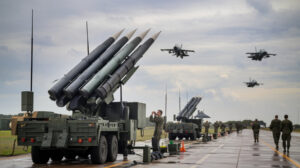The Anti-Aircraft Warfare Market is a cornerstone of modern defense systems, evolving rapidly to counter increasing threats in the airspace. Estimated at USD 20.9 billion in 2023, the market is expected to grow at a CAGR of 6.5%, reaching USD 28.6 billion by 2028. This growth is fueled by the need for advanced air defense technologies, including hypersonic missile systems, radar systems, and directed energy weapons.
What is Anti-Aircraft Warfare?
Anti-aircraft warfare (AAW) encompasses strategies and systems designed to neutralize aerial threats such as missiles, drones, and aircraft. These systems include weapon systems, radar, and electronic warfare platforms that work together to detect, track, and destroy potential threats in real time.
How Anti-Aircraft Warfare Works
Anti-aircraft systems rely on advanced radar and sensors to identify incoming threats. Once detected, the systems employ command and control technology to direct interceptors or energy-based weapons to neutralize the targets. Key advancements include medium-range missile systems, which serve as a critical defense layer for strategic infrastructure.
Download PDF Brochure: https://www.marketsandmarkets.com/pdfdownloadNew.asp?id=29678979
Market Applications of Anti-Aircraft Warfare
The Anti-Aircraft Warfare Market supports a broad spectrum of defense applications:
Military Defense: Protecting national airspace from hostile threats through advanced radar and missile systems.
Naval Defense: Ensuring maritime security with systems installed on destroyers, corvettes, and unmanned surface vehicles.
Critical Infrastructure Protection: Guarding airports, government facilities, and military bases against air threats.
Market Drivers
Rising Demand for Indigenous Air Defense Systems
Countries like Russia, China, and India are heavily investing in indigenous air defense technologies. Notable systems include Russia’s S-500 system and China’s HQ-9B missile system.
Technological Advancements
Developments in radar systems, artificial intelligence, and hypersonic missile technology are driving the market. Enhanced detection and targeting capabilities are making defense systems more precise and reliable.
Increasing Air-Based Threats
The growing use of UAVs (drones) for military purposes has escalated the demand for sophisticated countermeasures, further boosting market growth.
Challenges in the Market
Stringent Arms Transfer Regulations
Government policies like the US Arms Export Control Act and the EU’s Common Position on Arms restrict the export of advanced defense technologies. These regulations hinder global market expansion.
Technical Challenges in Counter-UAV Systems
Detecting small, low-flying UAVs and managing swarms present significant technical hurdles. Addressing these issues requires substantial R&D investment.
Opportunities in Anti-Aircraft Warfare
Development of Directed Energy Weapons (DEWs)
Directed energy weapons, such as high-energy lasers and microwave-based systems, represent a transformative innovation. The U.S. Department of Defense, for instance, invests USD 1 billion annually in DEW technology to counter threats like drones.
Ask for Sample Report: https://www.marketsandmarkets.com/requestsampleNew.asp?id=29678979
Regional Insights
North America
The region leads the market, with major players like Lockheed Martin, Raytheon Technologies, and Northrop Grumman investing in cutting-edge technologies.
Europe
The region sees robust demand for air defense systems, supported by indigenous developments in countries like the UK and France.
Asia-Pacific
Countries such as China and India are making substantial strides in developing and deploying advanced air defense systems, bolstering the regional market.
Impact on Other Industries
Aerospace and Defense
The advancements in anti-aircraft warfare directly support innovations in the broader aerospace and defense sectors, including UAV development and avionics.
Energy Sector
The adoption of directed energy weapons highlights the need for compact and efficient power systems, driving advancements in energy storage and distribution technologies.
Key Players in the Anti-Aircraft Warfare Market
- Lockheed Martin Corporation (US)
- Raytheon Technologies Corporation (US)
- BAE Systems (UK)
- Thales Group (France)
These companies lead the market, leveraging their expertise to develop innovative systems for global defense.
Key Takeaways
- The Anti-Aircraft Warfare Market is projected to grow from USD 20.9 billion in 2023 to USD 28.6 billion by 2028, with a CAGR of 6.5%.
- Rising threats, technological advancements, and investments in indigenous systems drive market growth.
- The naval segment dominates, accounting for 55% of the market in 2023, followed by medium-range systems with a 53.3% share.
- North America holds the largest market share, driven by significant R&D investments.
To Gain Deeper Insights Into This Dynamic Market, Speak to Our Analyst Here: https://www.marketsandmarkets.com/speaktoanalystNew.asp?id=29678979
FAQs
What are Anti-Aircraft Warfare systems?
They are systems designed to detect, track, and neutralize aerial threats such as missiles and drones.
Which region dominates the Anti-Aircraft Warfare Market?
North America leads the market due to its advanced defense infrastructure and significant investments.
What drives the market’s growth?
Key drivers include technological advancements, rising threats, and increased demand for indigenous air defense systems.
Who are the top players in the market?
Major players include Lockheed Martin, Raytheon Technologies, BAE Systems, and Thales Group.
What are directed energy weapons?
These are weapons that use electromagnetic energy, such as lasers, to neutralize threats effectively.
